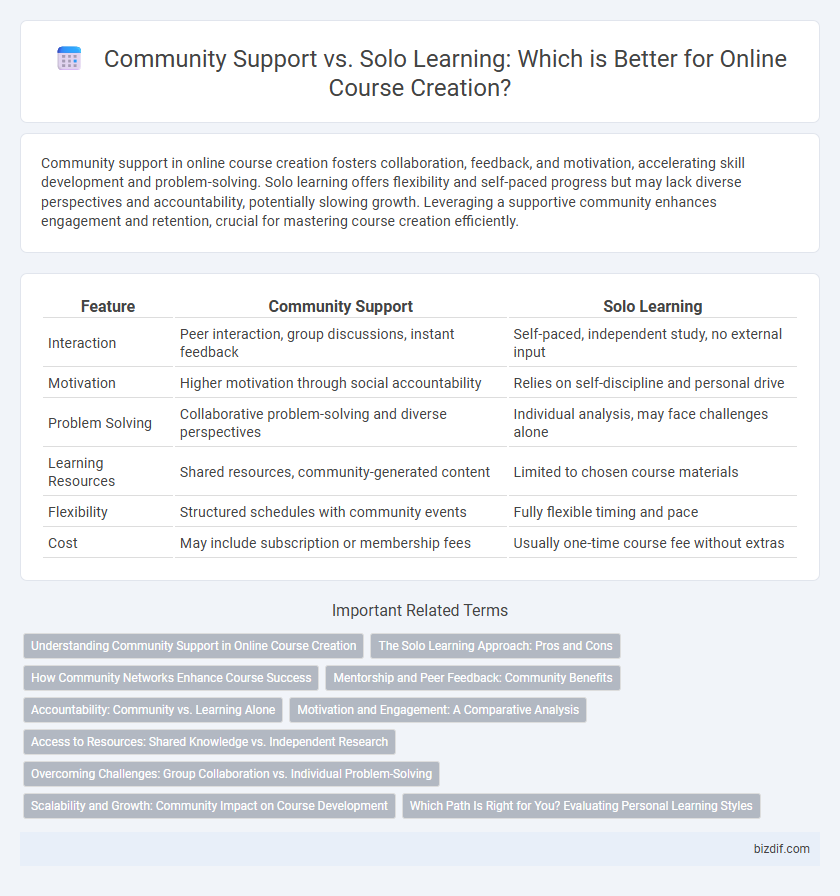Community support in online course creation fosters collaboration, feedback, and motivation, accelerating skill development and problem-solving. Solo learning offers flexibility and self-paced progress but may lack diverse perspectives and accountability, potentially slowing growth. Leveraging a supportive community enhances engagement and retention, crucial for mastering course creation efficiently.
Table of Comparison
| Feature | Community Support | Solo Learning |
|---|---|---|
| Interaction | Peer interaction, group discussions, instant feedback | Self-paced, independent study, no external input |
| Motivation | Higher motivation through social accountability | Relies on self-discipline and personal drive |
| Problem Solving | Collaborative problem-solving and diverse perspectives | Individual analysis, may face challenges alone |
| Learning Resources | Shared resources, community-generated content | Limited to chosen course materials |
| Flexibility | Structured schedules with community events | Fully flexible timing and pace |
| Cost | May include subscription or membership fees | Usually one-time course fee without extras |
Understanding Community Support in Online Course Creation
Community support in online course creation enhances motivation and accountability by fostering interaction among learners and instructors. Shared resources, peer feedback, and collaborative problem-solving accelerate skill acquisition and improve course completion rates. This interactive environment creates a dynamic learning experience that solo learning often lacks, leading to higher engagement and better outcomes.
The Solo Learning Approach: Pros and Cons
The solo learning approach in online course creation allows learners to progress at their own pace, fostering independence and self-discipline with minimal distractions. However, it lacks the community support found in group settings, which can result in limited feedback, reduced motivation, and fewer opportunities for collaborative problem-solving. While solo learning offers flexibility, it requires strong self-motivation and can lead to feelings of isolation without peer interaction.
How Community Networks Enhance Course Success
Community networks foster collaboration, knowledge sharing, and motivation, significantly enhancing online course completion rates compared to solo learning. Learners benefit from peer feedback, diverse perspectives, and real-time problem solving, which deepens understanding and retention of course material. Strong community support networks also create accountability, increasing learner engagement and overall course success metrics.
Mentorship and Peer Feedback: Community Benefits
Community support in online course creation offers invaluable mentorship and peer feedback that solo learning often lacks. Engaging with peers accelerates skill development by providing diverse perspectives, real-time problem-solving, and constructive critique. Mentorship within a community fosters accountability, motivation, and personalized guidance, significantly enhancing the overall learning experience.
Accountability: Community vs. Learning Alone
Community support in online course creation fosters accountability through shared goals and peer motivation, significantly increasing course completion rates. Solo learning often struggles with maintaining discipline and consistency, as learners lack external accountability mechanisms. Engaging in a community provides timely feedback and encouragement, essential for sustained progress and skill mastery.
Motivation and Engagement: A Comparative Analysis
Community support in online course creation significantly boosts motivation by fostering peer interaction and shared accountability, which enhances student engagement through collaborative learning environments. Solo learning often faces challenges in sustaining motivation due to lack of social reinforcement, potentially leading to lower course completion rates. Engaging community platforms increase retention by providing feedback loops, social proof, and encouragement, creating a dynamic learning experience compared to solitary study.
Access to Resources: Shared Knowledge vs. Independent Research
Community support in online course creation offers access to diverse resources through shared knowledge, including peer feedback, collaborative problem-solving, and curated content from multiple perspectives. Solo learning depends on independent research, requiring learners to seek out materials individually, which can limit exposure to varied insights and slow the learning process. Access to a supportive community enhances resource availability, accelerates problem resolution, and enriches understanding through collective expertise.
Overcoming Challenges: Group Collaboration vs. Individual Problem-Solving
Community support in online course creation fosters diverse perspectives and collaborative problem-solving, enabling learners to overcome obstacles through shared experiences and collective brainstorming. Solo learning emphasizes personalized strategies and self-paced development, which cultivates independence and critical thinking when addressing challenges. Group collaboration enhances motivation and accountability, while individual problem-solving strengthens adaptability and resilience in mastering course material.
Scalability and Growth: Community Impact on Course Development
Community support significantly enhances scalability and growth in online course creation by fostering active collaboration and continuous feedback among learners, which drives iterative improvements and content diversification. Solo learning limits scalability due to the absence of diverse perspectives and real-time engagement, slowing course evolution and market reach expansion. Leveraging community impact accelerates course development cycles and cultivates a loyal user base, ultimately increasing course success and revenue potential.
Which Path Is Right for You? Evaluating Personal Learning Styles
Community support in online course creation fosters collaboration, immediate feedback, and diverse perspectives, crucial for learners who thrive in interactive environments. Solo learning suits those with strong self-discipline and a preference for personalized pacing, enhancing focus and deep understanding without external pressures. Assessing your learning style, motivation levels, and need for accountability helps determine whether a community-driven or independent approach best supports your educational goals.
Community support vs Solo learning Infographic

 bizdif.com
bizdif.com